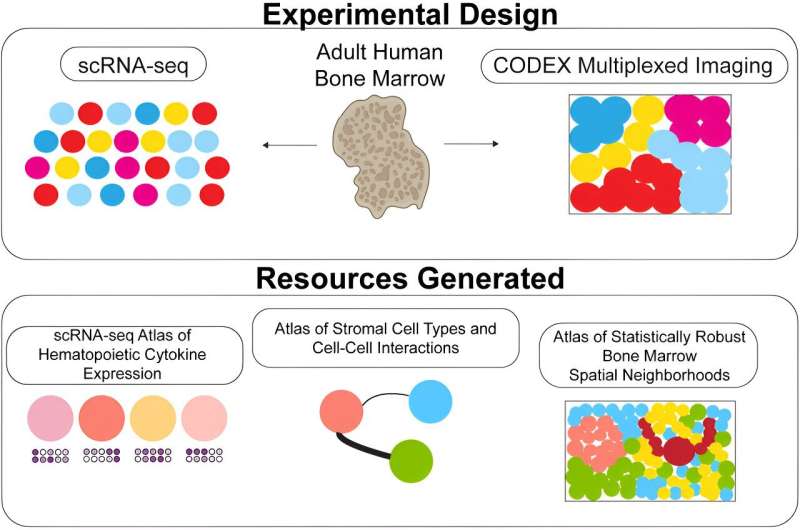This article has been reviewed according to Science X's editorial process and policies. Editors have highlighted the following attributes while ensuring the content's credibility:
fact-checked
peer-reviewed publication
trusted source
proofread
Rare bone marrow cells revealed in new comprehensive atlas

While research has uncovered many details about how blood cells function within bone marrow, the work of other cells existing in that space has remained a relative mystery. Now, researchers from the Perelman School of Medicine at the University of Pennsylvania and Children's Hospital of Philadelphia (CHOP) have published a "bone marrow atlas" in Cell that provides a first-of-its-kind, full view of all the cells existing within it, offering a better understanding of both healthy and diseased blood production.
"For the first time, we will have a comprehensive framework to view the full gene expression and spatial organization of bone marrow cells," said senior study author Kai Tan, Ph.D., a professor of Pediatrics in the Perelman School of Medicine and an investigator in CHOP's Center for Childhood Cancer Research. "Although our paper is foundational, we envision the atlas will be used to develop new diagnostic tests, identify new CAR-T or other therapeutic targets, and discover spatial biomarkers of disease."
Bone marrow mostly consists of blood cells. However, a small percentage of non-blood cells may play an important role in conditions such as leukemia, other blood cancers, or bone marrow failure syndromes. Through the team's efforts, researchers and doctors now have a much clearer picture of the functions of the rarer but key cells in the bone marrow such as stromal cells, bone cells, and endothelial (blood vessel) cells.
By using single-cell RNA sequencing, the researchers were able to capture the full gene expression profiles of tens of thousands of individual cells, uncovering the complete mix of cell types that make up an organ.
Through work aided by both an artificial intelligence technique called machine learning and painstaking hand-labeling of individual cells, the team was able to discern both that healthy bone marrow has very distinct spatial organization and stromal cells are more closely associated with blood-producing cells than previously understood.
As a result, researchers were able to create an encyclopedia cataloging which of these rare non-blood cells produce factors known to be important in human blood production, which will help guide researchers to focus on future studies.
"When applied to leukemia patient samples, these techniques identify the expansion of mesenchymal cells, a type of rare non-blood cell, at the cancer cell site in the bone marrow," said the study's co-senior author Ling Qin, Ph.D., a professor of Orthopedic Surgery at Penn Medicine. "This reveals a potential new direction for future disease treatment."
The study is part of the broader Human BioMolecular Atlas Program (HuBMAP), which includes 42 diverse research teams at universities across 14 states and four countries. Researchers are collaborating to create the next generation of molecular analysis technologies and computational tools, which will allow researchers to create foundational tissue maps and construct a full map, or atlas, of the function and relationships among cells in the human body.
"Studies of this magnitude are only possible with monumental team efforts," said Shovik Bandyopadhyay, Ph.D., a lead author of the study and a physician-scientist in-training in Tan's lab. "With the collaboration of multiple institutions and scientific consortia, we were able to gain fundamental insight into the microscopic building blocks of the human body."
Overall, the team is optimistic about the doors their techniques and research are opening.
"We are just beginning to scratch the surface of what's possible," Tan said. "Future research can build on our work, expediting bone marrow studies with the hope that one day these digital pathways will lead to health care breakthroughs in acute leukemia and other bone marrow disorders."
More information: Shovik Bandyopadhyay et al, Mapping the cellular biogeography of human bone marrow niches using single-cell transcriptomics and proteomic imaging, Cell (2024). DOI: 10.1016/j.cell.2024.04.013
Journal information: Cell



















